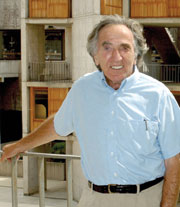Leslie Orgel facts for kids
Quick facts for kids
Leslie Eleazer Orgel
|
|
|---|---|
 |
|
| Born | 12 January 1927 |
| Died | 27 October 2007 (aged 80) |
| Nationality | |
| Alma mater | University of Oxford California Institute of Technology University of Chicago |
| Known for | Orgel diagram Origin of life Orgel's rules |
| Awards | Fellow of the Royal Society |
| Scientific career | |
| Fields | Chemistry |
| Institutions | University of Oxford University of Cambridge |
Leslie Eleazer Orgel (born January 12, 1927 – died October 27, 2007) was a British chemist. He was famous for his ideas about how life first began on Earth.
Contents
About Leslie Orgel
Leslie Orgel was born in London, England. He studied chemistry at the University of Oxford and earned his first degree in 1948. Later, in 1953, he received his PhD in chemistry.
Orgel started his work as a theoretical inorganic chemist. He continued his studies at Oxford, the California Institute of Technology, and the University of Chicago.
In April 1953, Orgel was one of the first people to see the model of DNA's structure. This model was built by Francis Crick and James Watson. Orgel and other scientists were working at Oxford University at the time. He later worked with Crick at the Salk Institute for Biological Studies.
In 1955, he joined the chemistry department at Cambridge University. There, he studied transition metal chemistry. He also wrote a textbook called Transition Metal Chemistry: Ligand Field Theory. Orgel also created the Orgel diagram, which helps explain how electrons behave in certain chemicals.
In 1964, Orgel moved to the Salk Institute for Biological Studies in La Jolla, California. He led the Chemical Evolution Laboratory there. He was also a professor at the University of California, San Diego. Orgel was part of the NASA team that studied exobiology, which is the study of life beyond Earth.
Orgel and the Mars Mission
Orgel helped design a special instrument for NASA's Viking Mars Lander Program. This instrument was a gas chromatography mass spectrometer. Robots took it to the planet Mars to look for signs of life.
Medical Discoveries
Orgel's lab found an easy way to make cytarabine. This compound is now a common anti-cancer medicine.
Orgel's Rules
Orgel is also known for "Orgel's Rules." His Second Rule states: "Evolution is cleverer than you are." This means that natural processes can create amazing things that are hard for humans to imagine.
In his book The Origins of Life, Orgel talked about "specified complexity." This idea helps explain how living things are different from non-living things. He wrote over 300 articles in his research fields.
Leslie Orgel passed away on October 27, 2007, from pancreatic cancer.
Research on the Origin of Life
Leslie Orgel spent much of his career researching how life began on Earth. He focused on how the basic building blocks of life could have formed.
How Nucleobases Formed
Orgel suggested a new idea for how nucleobases (parts of DNA and RNA) could have formed on early Earth. Scientists knew that hydrogen cyanide (HCN) could form adenine, a nucleobase. But the problem was that it needed a very high concentration of HCN.
Orgel thought that if HCN was frozen in water, it would become more concentrated. This would happen in the tiny spaces within the ice crystals. This idea also solved the problem of HCN evaporating too quickly in liquid water.
How Nucleosides Formed
For nucleosides (a nucleobase plus a sugar), Orgel suggested heating a mix of sugar and nucleobases. He used hypoxanthine, adenine, and guanine with magnesium ions. This process helped the parts connect correctly.
How RNA Molecules Formed
Orgel also studied how RNA could have formed on early Earth. He looked for ways that simple chemicals could combine to make longer RNA chains. He found that certain chemicals could help connect the building blocks of RNA.
He also thought that one strand of RNA could have been a template for the first life. This template would help other RNA building blocks connect and copy themselves.
Life from Space?
Orgel, along with Francis Crick, also explored the idea of panspermia. This is the idea that life on Earth might have come from space. They even suggested that life on Earth could have been sent here by an alien species. They even thought about what kind of spaceship aliens might have used!
The RNA World Idea
In the late 1960s, Orgel proposed a big idea: that early life was based on RNA, not DNA or proteins. He thought that RNA could act as both genes and enzymes (molecules that speed up chemical reactions). This idea later became the widely accepted RNA world hypothesis.
Years later, Orgel wrote a detailed review about the RNA World hypothesis. He noted how important the discovery of ribozymes was. Ribozymes are RNA molecules that act like enzymes, just as Orgel had predicted.
Orgel concluded that even with much progress, the full story of how the RNA World began was still a mystery.
Awards and Honors
- Elected to the National Academy of Sciences in 1990.
- Elected as a Fellow of the Royal Society of London in 1962.
- Member of the American Academy of Arts and Sciences.
Books by Leslie Orgel
- Leslie E. Orgel, An Introduction to Transition-Metal Chemistry. The Ligand Field Theory, 1961
- Leslie E. Orgel, The Origins of Life: Molecules and Natural Selection, 1973
- Leslie E. Orgel and Stanley L. Miller, The Origins of Life on the Earth, 1974
See also
 In Spanish: Leslie Orgel para niños
In Spanish: Leslie Orgel para niños

